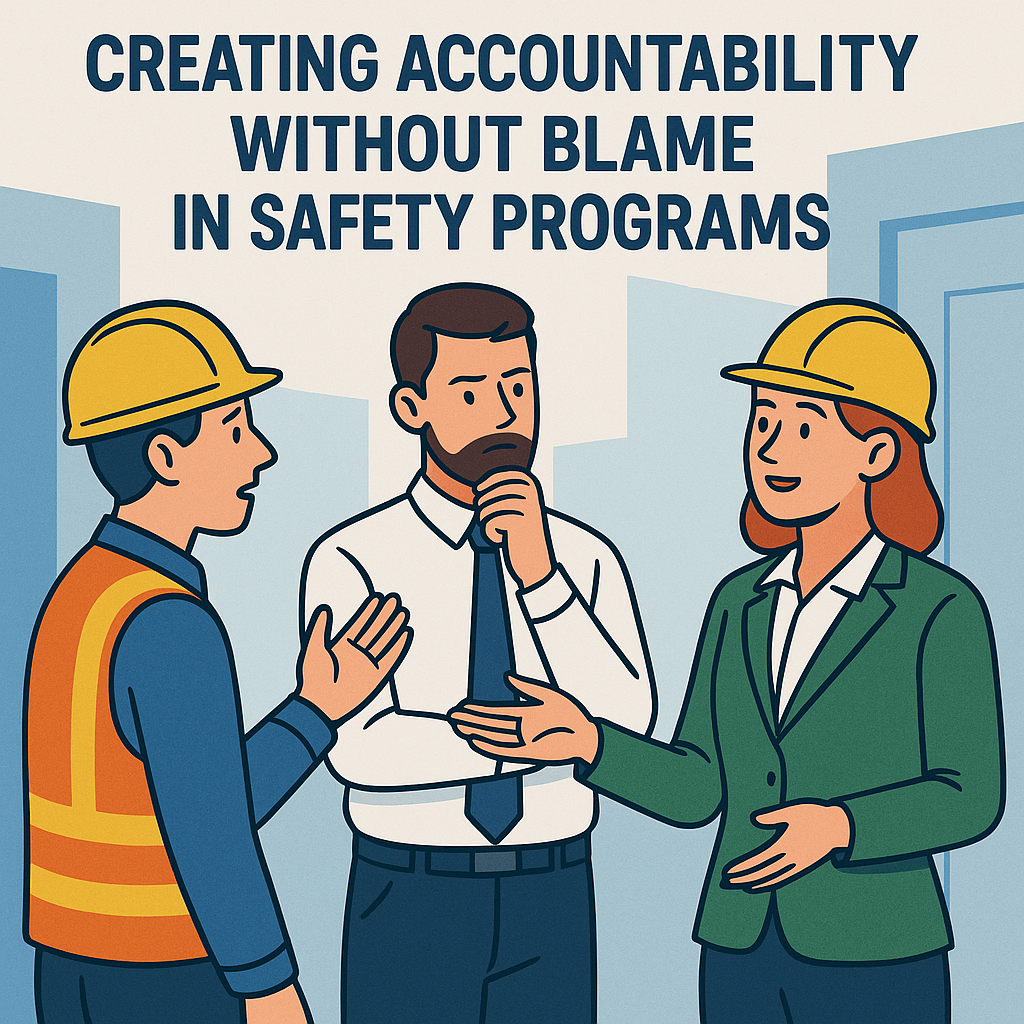- Why Accountability Without Blame Is Critical in Safety Culture
- The Problem With Blame-Based Safety Models
- What Is a Blame-Free Safety Culture?
- Benefits of a Blame-Free Accountability Approach
- Strategies to Create Accountability Without Blame
- Real-World Example: A Turnaround Story
- Common Pitfalls to Avoid
- Tools and Resources to Support a No-Blame Culture
- Blame Fixes Nothing. Ownership Fixes Everything.
Why Accountability Without Blame Is Critical in Safety Culture
In safety management, the phrase “accountability” often carries a heavy connotation—discipline, punishment, or finger-pointing after something goes wrong.
But in high-performing organizations, accountability looks very different: it’s shared, proactive, and blame-free.

Creating Accountability Without Blame in Safety Programs means building a culture where workers feel responsible for their actions and empowered to speak up—without fear of retribution.
This environment leads to better hazard identification, more accurate reporting, and fewer repeat incidents.
The Problem With Blame-Based Safety Models
Many organizations unintentionally create a fear-based reporting environment where workers:
- Hide mistakes or near-misses
- Avoid reporting incidents
- Distrust safety investigations
- Resent management
This undermines the very foundation of your safety program. If employees don’t feel safe to tell the truth, you’re managing what you know—not what’s actually happening.
What Is a Blame-Free Safety Culture?
A blame-free safety culture does not mean there’s no accountability. It means separating human error and systemic failure from reckless behavior. It’s about:
- Investigating incidents without immediate judgment
- Learning from errors instead of punishing them
- Understanding the “why” behind unsafe actions
- Focusing on root causes—not scapegoats
This approach aligns with modern concepts like Just Culture, where consequences are fair and contextual.
Benefits of a Blame-Free Accountability Approach
✅ 1. Encourages Open Reporting
Workers will speak up if they know it won’t cost them their job—or reputation.
✅ 2. Improves Root Cause Analysis
You’ll get honest insights into how and why things went wrong, which leads to real prevention.
✅ 3. Strengthens Team Morale
When safety is about support and solutions, trust and teamwork naturally grow.
✅ 4. Drives Continuous Improvement
Blame-free systems invite ideas, innovations, and ownership of safety from every level of the organization.
Strategies to Create Accountability Without Blame

🧠 1. Educate Leaders on Just Culture
Train supervisors and managers to distinguish between:
- Human error (e.g., forgetfulness, oversight)
- At-risk behavior (e.g., shortcuts due to pressure)
- Reckless behavior (e.g., willful violations)
Respond proportionally—and with the intent to learn, not punish.
📊 2. Use Systems Thinking in Incident Investigations
Ask:
- Was the procedure unclear?
- Was the timeline unrealistic?
- Did the employee have proper tools or training?
Tools like the 5 Whys or Bowtie Analysis help shift focus from the individual to the environment.
📣 3. Reinforce Positive Accountability
Highlight cases where employees:
- Reported near-misses
- Helped peers avoid hazards
- Took responsibility and improved processes
Public recognition shows that accountability is valued—not feared.
🗂 4. De-identify Reporting Where Possible
Allow anonymous hazard or near-miss reports. Focus on learning from the data rather than identifying a person to blame.
💬 5. Make Feedback Routine and Respectful
Use coaching language like:
- “Help me understand what happened.”
- “What could’ve made this task safer?”
- “How can we improve this process together?”
This builds ownership instead of defensiveness.
Real-World Example: A Turnaround Story
A packaging plant in Quebec struggled with underreporting and blame culture. After training supervisors in Just Culture principles and implementing anonymous reporting:
- Hazard reports increased by 200%
- Lost-time injuries dropped by 37% in one year
- Employee satisfaction scores (safety section) rose from 58% to 82%
The shift from fear to fairness made all the difference.
Common Pitfalls to Avoid
- Using safety stats for punishment or bonuses: This incentivizes underreporting.
- Ignoring the role of systems in incidents: Most unsafe acts have deeper causes.
- Blaming new hires disproportionately: Inexperience is a factor—but so is training quality and supervision.
Tools and Resources to Support a No-Blame Culture
- OHSE.ca – Canadian safety tools and training materials
- CCOHS Just Culture Resources
- Digital incident management platforms with anonymous reporting and trend analysis
- Leadership coaching programs on emotional intelligence in safety
Blame Fixes Nothing. Ownership Fixes Everything.
True safety accountability comes from trust, clarity, and culture. By removing fear and focusing on learning, you empower every worker to be part of the solution.
Accountability Without Blame in Safety Programs isn’t just good ethics—it’s good strategy. When you create an environment where people feel safe to be honest, your workplace becomes truly safe.


No comments yet